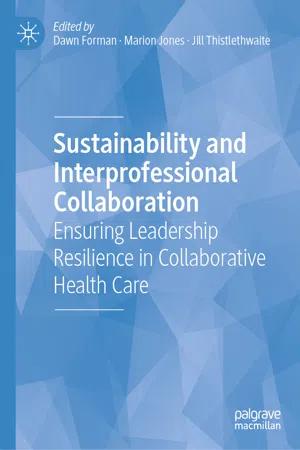Introduction
Interprofessional collaboration has grown significantly in health care organisations, becoming a critical part of the way in which health and social care is delivered. It is now seen as an essential part of effective health care delivery. Health professionals can be assigned to designated teams due to the increasing complexity of health care delivery, or more commonly a number of professionals with different expertise work together in collaborations which can be configured over some distance (Thistlethwaite, Dunston, & Yassine, 2019).
Since our last book we have also seen a growth in the amount of interprofessional research taking place (M. A. Girard, 2019; Wooding, Gale, & Maynard, 2019).
In spite of the growth in research and the increase in interprofessional education, practice and collaboration internationally, there seems to be a difficultly both in sustaining good practice when there is a change in leadership and ensuring both individual practitioners (Dunston et al., 2018) and interprofessional teams have the resilience to cope with education and health care changes (McCann et al., 2013).
This chapter proves a taster for these terms and introduces the key themes of this book.
Sustainability
To ensure the sustained development of interprofessional skills and thereby the continuity of effective health care teams we need to ensure the philosophy, policies and procedures are so embedded that these will exist, continue and develop even if there is a change of leadership. In research in this area Micklan and Rodger (2005) undertook a study involving 202 health care professionals; participants identified leadership as the most significant factor in maintaining interprofessional teamwork effectiveness. Sharing leadership functions was critical to the teams’ performance.
Leadership commitment is therefore not only necessary from the top but from the team itself. For example if one professional is absent in a multidisciplinary team, a key leadership role would be to ensure resources are in place to provide the professional specific support required. In practice this may need political knowledge and strategies to fight for resources and lobby key players in economically tough times.
But, what happens when the top leader changes and the new leader does not see interprofessional collaboration as a priority? To ensure the sustainability of interprofessional collaboration we need to ensure the policies and procedures are reinforced with regulations and good governance systems.
M. A. Girard (2019) following research into regulations in interprofessional collaboration concluded that to strengthen interprofessional collaboration, there must be more socio-legal research to properly address and inform policymakers.
As you will read (Chapter
8) one of the countries leading in creating a sustainable
governance system is
Australia where the recent research undertaken there aimed to:
Implement an innovative, consensus-based and sustainable approach to the governance and further development of interprofessional education across Australian health professional education. (Dunston et al. 2019)
Resilience
Until this book the only
article that seems to address resilience in
health professionals was a review of the
resilience literature by McAllister and McKinnon (
2009). They confirm that resilience in the health professions involves a combination of
individual and contextual factors. They make three recommendations for building
resilience in
health professionals:
- 1.
that the concept of resilience is introduced in all training programmes—including both individual and team resilience
- 2.
that practitioners are given opportunities to reflect and learn from experience and other practitioners and
- 3.
that experienced health professionals share lessons from experiences and encourage mentoring, leading, coaching and motivating others.
Earlier research seemed to indicate that team resilience also correlated positively with team optimism and satisfaction (Delarue, Van Hootegem, Procter, & Burridge, 2008; Tugade & Fredrickson, 2004) suggest resilience is the ability to bounce back from negative emotional experiences, and flexible adaptation to the changing demands of stressful experiences.
We have taken the term resilience to mean the intrinsic ability of a health care system to adjust its functioning prior to, during, or following changes and disturbances so that it can sustain required operations, even after a major mishap or in the presence of continuous stress (Nemeth, Nunnally, & O’Connor, 2007), and there are many examples in this book of how interprofessional resilience is being developed and sustained.
The terms ‘
resilience’ and ‘
sustainability’ therefore seem to go together; as Meads, Jones, Harrison, Forman, and Turner (
2009) found in their research 10 aspects are necessary for sustainable change:
- 1.
Individual policies and projects
- 2.
New organisational relationships and structures
- 3.
- 4.
Multidisciplinary (interprofessional) research agendas
- 5.
Initiatives to promote participation
- 6.
- 7.
New operational procedures
- 8.
- 9.
Skills mix and skills substitution
- 10.
Many of these themes will be found recurring in this book along with examples as to how different organisations have developed resilient and sustainable interprofessional collaboration.
How to Use This Book
As with our previous books we hope this guide will help you dip in and out of the book and find what you are looking for within easy reach. We have separated the book into five parts.
Part 1—An Introduction to This Book and an Overview of the Situation
In addition to this chapter there is an overview of the interprofessional situation internationally by the esteemed Professor John Gilbert.
Part 2—Interprofessional Centres and Networks
This section will outline their experiences (some over many years) of how they have tried to bring together those involved in interprofessional education practice and research. The aim of these groups is usually to share good practice, but this demands a huge commitment on the part of the organisers and often this is difficult to sustain.
Part 3—Key Drivers
Different policies, practices, community needs, changes in funding or leadership, often impact on the development and sustainability of interprofessional practice and collaborative care. This section will outline the experiences of different organisations in diffe...
